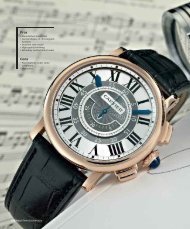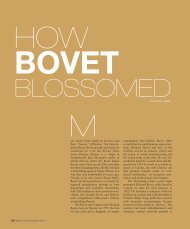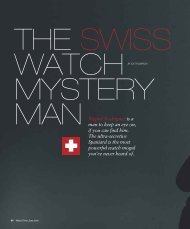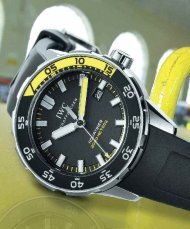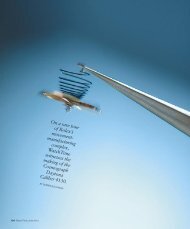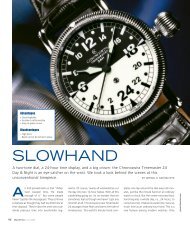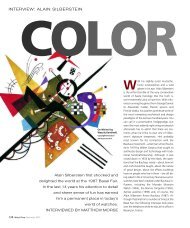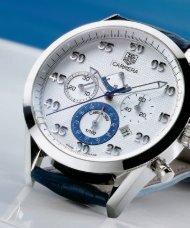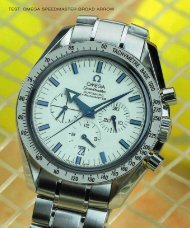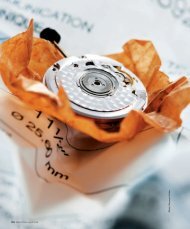WT_2006_03: CARL F. BUCHERER
WT_2006_03: CARL F. BUCHERER
WT_2006_03: CARL F. BUCHERER
You also want an ePaper? Increase the reach of your titles
YUMPU automatically turns print PDFs into web optimized ePapers that Google loves.
<strong>CARL</strong> F. <strong>BUCHERER</strong>:<br />
A SWISS ICON GOES GLOBAL<br />
Carl F. Bucherer’s<br />
Patravi TravelTec<br />
displays three<br />
time zones.<br />
Why does Switzerland’s most famous jeweler want to become an international watch brand<br />
BY JOE THOMPSON<br />
120 WatchTime June <strong>2006</strong>
One of the remarkable developments in<br />
Swiss watchmaking since the turn of the<br />
century is the proliferation of new highend<br />
brands. The boom in sales of Swiss luxury<br />
watches in the 1990s has spawned a Swisswatch<br />
baby boom in the 2000s.<br />
New brands, of course, are by definition unknown.<br />
Think of Greubel Forsey, Villemont,<br />
Vogard, de Witt, de Bethune, Jean Dunand,<br />
and a couple of dozen other fresh brands that<br />
have sprung up like edelweiss around Switzerland’s<br />
Jura Mountain watchmaking region.<br />
One new brand, however, that appeared for<br />
the first time at the 2001 Basel Fair was different.<br />
Its name was hardly obscure; indeed, it is<br />
one of the most famous brand names in<br />
Switzerland, recognized not only by the Swiss<br />
but by generations of visitors to Switzerland<br />
from all over the world.<br />
The name is Bucherer. The new brand was<br />
Carl F. Bucherer, named for the founder of<br />
Bucherer, Switzerland’s biggest and bestknown<br />
retail jeweler.<br />
Bucherer is a Swiss icon. Carl Friedrich<br />
Bucherer and his wife Luise opened their first<br />
jewelry shop in Lucerne in 1888. In the past century-plus,<br />
it has enjoyed unparalleled success<br />
among Swiss jewelry retailers. For legions of<br />
people, a trip to Switzerland would not be complete<br />
without a visit to Bucherer’s flagship store<br />
in Lucerne or to one of 12 other Bucherer shops<br />
around Switzerland. Today, the Bucherer Group,<br />
headed by Carl-Friedrich’s grandson, Jörg G.<br />
Bucherer, is one of Switzerland’s most prominent<br />
retail companies, with 33 stores in Switzerland,<br />
Germany and Austria. Privately owned by<br />
the Bucherer family, Bucherer has a workforce<br />
of 1,200 and total estimated annual revenues of<br />
400 million Swiss francs ($320 million).<br />
Why would Switzerland’s biggest and bestknown<br />
jeweler, which sells more than a dozen<br />
top Swiss watch brands ranging from Audemars<br />
Piguet to Swatch, and which also happens<br />
to be the world’s largest seller of Rolex<br />
watches, want to launch a global watch brand<br />
of its own<br />
It’s a good question. To find out, WatchTime<br />
met recently with executives of Bucherer Montres<br />
S.A. in Lucerne, the watchmaking subsidiary<br />
of the Bucherer Group.<br />
The Bucherer flagship store on Schwanenplatz in Lucerne<br />
Bucherer Plus<br />
The answer is pretty simple: know-how.<br />
Bucherer, it turns out, is not exactly a watchmaking<br />
newbie. The firm has been producing<br />
Bucherer-brand watches in Switzerland for sale<br />
in its stores for nearly 90 years. Bucherer has a<br />
surprisingly rich résumé as a watch producer,<br />
as its impressive company archive, on display<br />
at its manufacturing facility in Lengnau, near<br />
Bienne, attests (see sidebar). At its peak,<br />
Bucherer produced 80,000 watches per year, a<br />
full range of men’s and ladies’ watches designed<br />
to appeal to the diverse tastes of its domestic<br />
and foreign clientele. For one nine-year<br />
stretch in the 1960s and ’70s, Bucherer was<br />
Switzerland’s third-largest producer of chronometer<br />
watches, after Rolex and Omega.<br />
When 10 of Switzerland’s top watch guns<br />
joined forces in the 1960s to pool resources<br />
and develop the world’s first quartz watch<br />
movement, Beta 21, Bucherer was among<br />
them.<br />
Inevitably, Bucherer’s in-house watchmakers<br />
dreamed of seeing their creations go beyond<br />
Bucherer’s network of stores as part of an<br />
international brand. Kurt Allemann, executive<br />
vice president for product at Bucherer Montres,<br />
has been with Bucherer’s watch division<br />
since 1977. About going global with the<br />
Bucherer brand, he says, “We always wanted<br />
to do it.”<br />
That notion became more than a fantasy in<br />
the late 1990s, when the luxury watch market<br />
was booming and the industry was rapidly<br />
June <strong>2006</strong> WatchTime 121
<strong>CARL</strong> F. <strong>BUCHERER</strong><br />
Chairman Jörg G. Bucherer<br />
Founder Carl F. Bucherer<br />
consolidating. Many jewelers watched with<br />
alarm as previously independent brands like<br />
Jaeger-LeCoultre, IWC Schaffhausen, Breguet,<br />
TAG Heuer, Panerai and Zenith, among<br />
others, wound up in the arms of the industry’s<br />
Big Three giant groups (Swatch Group,<br />
Richemont, and LVMH). Some in Bucherer<br />
reckoned the time was right to capitalize on<br />
Bucherer’s expertise as a watch and jewelry<br />
manufacturer and turn the house brand into<br />
a new, independent watch company. Marcel<br />
Hossli, a Bucherer marketing executive, became<br />
a forceful proponent of what came to<br />
be called the Bucherer Plus project. Hossli’s<br />
SWOT analysis indicated that the strengths<br />
and opportunities of a global Bucherer watch<br />
brand far outnumbered the weaknesses and<br />
threats. He argued that Bucherer’s existing<br />
know-how and wide brand recognition<br />
would enable it to build a second strategic<br />
pillar to complement retailing. In 2000,<br />
Bucherer chairman Jörg Bucherer gave the<br />
idea his enthusiastic blessing and the project<br />
was a go.<br />
They selected the Carl F. Bucherer name to<br />
honor the founder and give the watch brand<br />
an identity separate from the Bucherer shops.<br />
To launch it, Bucherer tapped watch expertise<br />
from inside and outside the firm. It restructured<br />
its watch division and set up Bucherer<br />
Montres as a separate subsidiary. As CEO they<br />
brought in Thomas Morf from Maurice Lacroix.<br />
Allemann and Hossli moved from<br />
Bucherer to the new subsidiary as executive<br />
vice president of product and marketing, respectively.<br />
For executive vice president of<br />
sales, Morf hired Jürg Monstein, a colleague<br />
at Maurice Lacroix.<br />
In 2001, the launch year, Bucherer acquired<br />
the watch factory in Lengnau, and showed up<br />
at Basel with its first model, the Patravi Chro-<br />
DATA<br />
<strong>CARL</strong> F. <strong>BUCHERER</strong> PATRAVI TRAVELTEC GMT<br />
Manufacturer: Bucherer Montres S.A.,<br />
Lucerne, Switzerland<br />
Reference number: 00.10620.08.63.01(strap),<br />
21(bracelet)<br />
Functions: Hours, minutes, seconds; chronograph<br />
with 12 hour, 30-minute and 1/5-second<br />
indicators; date; GMT with three time zone<br />
indications<br />
Movement: CFB 1901 automatic caliber with an<br />
ETA 2894 base; COSC-certified chronometer; 39<br />
jewels; 42-hour power reserve<br />
Case and band: stainless steel case or rose<br />
gold case with exhibition window on side,<br />
screw-in crown, double-sided non-reflective<br />
sapphire crystal, diameter = 46.6 mm, waterresistance<br />
= 50 meters, calf leather strap with<br />
folding clasp; stainless steel bracelet<br />
Price: $10,400 stainless steel on strap; $10,900<br />
stainless steel on bracelet; $39,500 rose gold on<br />
strap<br />
CEO Thomas Morf<br />
nograph GMT with an unusual movement,<br />
CFB 1901, developed in-house. Patravi is the<br />
firm’s leader line. The name is meant to define<br />
the target audience: high achievers with an independent<br />
streak. Patravi is a Latin word that<br />
translates literally as “I have succeeded.”<br />
Five years on, Morf says, “We are still in the<br />
launch phase.” Nevertheless, he and his team<br />
can already declare “Patravi!” about their first<br />
goal. They have succeeded in transforming<br />
Bucherer’s house brand into a bona fide watch<br />
company. Bucherer Montres has created three<br />
core collections, Patravi for men, Alacria for<br />
women, and a new men’s line Manero, which<br />
debuted at Baselworld <strong>2006</strong> in late March.<br />
The firm expects to produce 12,000 Carl F.<br />
Bucherer watches this year. It is active in a<br />
dozen major global markets, including the<br />
United States of America, with watches priced<br />
from $2,000 to $12,000; limited-edition<br />
pieces cost substantially more. Its strategy is to<br />
carve a niche for itself in the high end of the<br />
Swiss watch market, somewhere below Patek<br />
Philippe and above Omega, Morf says.<br />
In addition, Bucherer Montres produces<br />
30,000 to 40,000 B-Swiss brand watches<br />
each year for the Bucherer stores. B-Swiss is<br />
122 WatchTime June <strong>2006</strong>
Assembling watches at the Carl F. Bucherer factory in Lengnau, Switzerland<br />
The new Manero Retrograde marks the debut<br />
of a new Carl F. Bucherer collection.<br />
the successor to the Bucherer brand, which is<br />
being phased out to eliminate any confusion<br />
with the more upscale Carl F. Bucherer line. B-<br />
Swiss is positioned below Carl F. Bucherer;<br />
prices range from SF200 to SF1,000.<br />
Useful complications<br />
The Patravi collection best conveys what Carl<br />
F. Bucherer is about. Patravi consists of men’s<br />
mechanical watches combining so-called<br />
“useful” complications like chronographs,<br />
large dates, annual calendars and additional<br />
time zones. “We wanted to create technical<br />
watches with a more contemporary look,”<br />
Morf says. Take the original model, the Patravi<br />
Chronograph GMT. Its 39-jewel automatic<br />
Caliber CFB 1901 (with an ETA 2894 base)<br />
features a sophisticated dual-time-zone<br />
mechanism with a “quick set” feature. It was<br />
developed by the company in collaboration<br />
with a mechanical movement specialist. It allows<br />
the wearer to use the crown to set the<br />
hour hand independently of the minute hand.<br />
The date at 4 o’clock adjusts automatically as<br />
the hour is set, forwards as well as backwards.<br />
A 24-hour bi-directional bezel serves<br />
as a third time-zone indicator.<br />
The firm followed that piece with a Patravi<br />
Chronograph Big Date (2002) inspired by a<br />
famous Bucherer big date chronograph from<br />
1948 that contained the famous Venus 210<br />
caliber. Carl F. Bucherer subsequently produced<br />
an annual calendar version of the<br />
Chronograph Big Date in 18k gold. The Patravi<br />
Tonneaugraph, introduced in 2004, put<br />
three features into a tonneau-shaped case: a<br />
chronograph, large date, and power-reserve<br />
indicator.<br />
The most complex Patravi yet, the Travel-<br />
Tec GMT, was announced at Baselworld 2005<br />
and comes to market this year. In this watch,<br />
a COSC-certified chronometer, Carl F.<br />
Bucherer has modified its CFB 1901 caliber<br />
with a new patented mechanism that displays<br />
three time zones at once. You set the<br />
local time via the crown, moving the hour<br />
hand an hour at a time. The watch continues<br />
to keep exact time while the time zone is being<br />
set. Should the time change pass midnight,<br />
the date changes automatically backward<br />
and forward. A red central 24-hour<br />
hand and two 24-hour rings on the perimeter<br />
of the dial give you the time in the other two<br />
zones. Using the crown, you set the red hand<br />
to the second time zone, indicated on the<br />
outer ring. You set the inner ring to the third<br />
time zone via the pusher located at 10 o’-<br />
clock. This patented mono-pusher for the<br />
third time zone is a watchmaking first. (A<br />
video showing how the TravelTec operates is<br />
available at www.carl-f-bucherer.com).<br />
When the watch was unveiled last year, it had<br />
a 42 mm. case. Now, though, it has grown to<br />
46.6 mm. They needed the larger case because<br />
of the greater torque required for the<br />
additional mechanism, Morf says. One unusual<br />
feature of the case is an exhibition window<br />
on the side that affords a view of movement.<br />
Production of the watch is limited due<br />
to its complexity; 25 of them will arrive in the<br />
United States in May, Morf says, priced at<br />
$10,400 on a leather strap and $10,900 on a<br />
steel bracelet. A limited-edition rose-gold<br />
version costs $39,500.<br />
124 WatchTime June <strong>2006</strong>
<strong>CARL</strong> F. <strong>BUCHERER</strong><br />
<strong>BUCHERER</strong>’S DEEP WATCH ROOTS<br />
Bucherer is renowned as Switzerland’s<br />
largest watch and jewelry retailer. The 118-<br />
year-old company’s credentials as a watch<br />
manufacturer are less well known. Here are<br />
some of the firm’s watchmaking highlights.<br />
1888: Watchmaker Carl Friedrich Bucherer<br />
and his wife Luise open their first<br />
shop in Lucerne.<br />
1915: Carl F. Bucherer’s son, Ernst, who with<br />
his brother Carl Eduard will eventually<br />
run the business, is appointed official<br />
watchmaker to Germany’s imperial<br />
court in Berlin.<br />
1919: Bucherer launches its first watch collection<br />
for sale in its store under the<br />
name C. Bucherer.<br />
1945: After World War II, many U.S. soldiers<br />
travel to Lucerne before returning to<br />
the United States. Bucherer estimates<br />
that thousands of Bucherer brand<br />
watches were brought to the United<br />
States by returning soldiers, greatly<br />
increasing the brand’s recognition in<br />
America.<br />
1948: Launch of the Bucherer Chronograph<br />
Big Date fitted with the very rare<br />
Venus 210 caliber.<br />
1964: Richard Nixon visits the Bucherer<br />
store in Lucerne and purchases a<br />
Bucherer chronometer watch.<br />
1967: Needing to boost watch production<br />
to meet demand, Bucherer takes over<br />
the Credos watch factory in Nidau, located<br />
in the Jura hills above Bienne.<br />
Credos was a well-known producer<br />
of chronometer watches. The result is<br />
that Bucherer joins the ranks of<br />
Switzerland’s top chronometer watch<br />
producers. Between 1968 and 1976<br />
Bucherer produces more than 15,000<br />
chronometers per year, ranking third<br />
in production after Rolex and Omega.<br />
1969: Bucherer joins a consortium of 10<br />
Swiss watch manufacturers to develop<br />
and produce the first Swiss quartz<br />
watch movement, Beta 21.<br />
1971: Bucherer presents the Archimedes<br />
Super Compressor watch, a large<br />
divers’ watch. Its solid watch case is<br />
water-resistant to 200 meters and its<br />
automatic movement features a<br />
world time mechanism.<br />
1994: Bucherer develops an automatic caliber<br />
with noted Lucerne watchmaker<br />
Jörg Spöring. The caliber has a full<br />
Chronograph Big Date, 1948<br />
calendar function showing the date,<br />
day of the week, month and phase of<br />
the moon, all of which are set by the<br />
crown.<br />
2001: Bucherer launches the Carl F. Bucherer<br />
brand and moves its factory to<br />
larger premises in Lengnau.<br />
Bucherer art déco watch Bucherer Chronometer, 1968<br />
Beyond Patravi<br />
Complementing Patravi is a second men’s line,<br />
the newly launched Manero collection. The<br />
round, tripartite Manero case measures 40<br />
mm. in diameter and is modeled on one of the<br />
old Bucherer models. The debut piece is the<br />
Manero Retrograde, containing the firm’s second<br />
developed-in-house caliber, CFB 19<strong>03</strong>,<br />
with an ETA base. The watch has four subdials,<br />
two round and two retrograde. It uses retrograde<br />
indicators for the date at 3 o’clock and<br />
42-hour power reserve display at 6 o’clock. A<br />
round subdial at 9 indicates the day of the<br />
week; the one at 12 is a 24-hour, second-timezone<br />
indicator. It comes in steel ($6,300 on a<br />
strap; $6,700 on a bracelet) and rose gold<br />
(around $17,000) versions. Later this year, CFB<br />
plans to unveil a gold Manero Perpetual Calendar<br />
watch, with a novel moon-phase indicator.<br />
The Carl F. Bucherer brand is not only for<br />
men, however. “Bucherer has a strong business<br />
with ladies’ jewelry watches,” Morf says.<br />
To maintain that tradition, CFB launched the<br />
Alacria line of curved rectangular watches<br />
126 WatchTime June <strong>2006</strong>
<strong>CARL</strong> F. <strong>BUCHERER</strong><br />
The limited-edition Tribute to Mimi watch contains calibers from the 1920s.<br />
three years ago. The watches, in steel or gold,<br />
some with diamonds and colored gemstones,<br />
come in three sizes, mini, midi and diva. Today,<br />
women’s watches represent 40% of sales.<br />
Finally, there are the limited editions. “A<br />
new brand like us has to make some noise,”<br />
Morf says with a smile. “The Patravi Fritz Brun<br />
was a test. I wanted to find out if we could sell<br />
watches at the $30,000-plus price point.” Patravi<br />
Fritz Brun was the firm’s first limited edition<br />
watch, a gold, COSC-certified, perpetual<br />
calendar chronograph that marked the 125th<br />
anniversary of the birth in Lucerne of the noted<br />
composer Fritz Brun. The watch aced the test.<br />
CFB produced 75 in rose gold ($32,000) and<br />
25 in white gold ($38,000) and sold every one.<br />
On the heels of that success, the company<br />
launched a limited-edition ladies’ watch last<br />
year. Tribute to Mimi is a modern interpretation<br />
of a vintage art déco diamond watch using<br />
original shaped calibers from the 1920s.<br />
The company will make 70 pieces priced at<br />
$53,000. The watch honors Wilhelmina<br />
“Mimi” Bucherer-Heeb, the daughter-in-law<br />
of Carl F. Bucherer. She and her husband, Carl<br />
Eduard Bucherer, had a watch and jewelry<br />
business in Santiago, Chile. In 1927, after a<br />
visit to Switzerland, she was returning to Chile<br />
aboard the Italian steamship Principessa<br />
Mafalda when it sunk off the Chilean coast.<br />
Mimi and 313 others perished. The wreck was<br />
never found. “Among the watches and jewels<br />
Gold Alacria watch with diamonds and<br />
python strap<br />
from Switzerland that were stored in the ship’s<br />
safe,” the company explains, “were also<br />
Mimi’s own watch, one of [Bucherer’s] first<br />
wristwatch models created for women: a diamond-studded<br />
work of art in the art déco<br />
style.”<br />
■<br />
WHEN HANS MET <strong>CARL</strong><br />
Rolex founder Hans Wilsdorf (left) with Ernst<br />
Bucherer, son of Carl F. Bucherer.<br />
One of the Bucherer Group’s claims to fame<br />
is that it is the world’s largest seller of Rolex<br />
watches. The two firms are today Switzerland’s<br />
largest luxury watch producer and<br />
largest luxury watch retailer. To a large extent<br />
that is due to a deal made more than 80<br />
years ago by the firms’ founders. Carl F.<br />
Bucherer and Hans Wilsdorf were rugged<br />
individualists, each of whom refused to join<br />
the powerful cartels that dominated<br />
Switzerland’s watch market in the early<br />
20th century. Instead, they defied the cartels<br />
and entered into one of the most successful<br />
collaborations in watch history.<br />
Lucien Trueb, in his book “The World of<br />
Watches” (Ebner Publishing International,<br />
New York, 2005) explains what happened.<br />
“The cooperation began in 1924 when Rolex<br />
refused to join the newly established<br />
Federation of the Swiss Watch Manufacturers<br />
(FH) while Bucherer would not join the<br />
Watch Retailers Federation. Thenceforth,<br />
Bucherer could not buy watches from FH<br />
members, while Rolex could not sell its<br />
watches through member-retailers in<br />
Switzerland. For decades, Rolex was only<br />
available at the Bucherer stores while<br />
Bucherer sold only Rolex and its own<br />
Bucherer watch brand.”<br />
The 1924 agreement, Bucherer says,<br />
“marked the start of an amicable and successful<br />
collaboration lasting to this day.”<br />
128 WatchTime June <strong>2006</strong>



